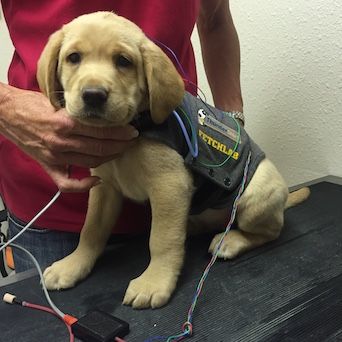University Audiologists Assess, Assist Hearing-Impaired Animals
Audiology students at 3 universities are administering hearing tests to animals through the FETCHLAB program.

Now hear this. The Universities of Cincinnati, Northern Colorado, and Akron have collaborated to create FETCHLAB—a program that enables audiology students to learn about and become certified in administering hearing tests and providing related services to animals.
“We train audiologists to work with humans of all ages in the diagnosis and treatment of hearing loss,” said Kathryn Bright, PhD, director of FETCHLAB at the University of Northern Colorado. “We believed that by giving our Doctor of Audiology students the opportunity to test animals, they could enhance their audiology skills at the same time that we provide a service to veterinarians, breeders and pet owners.”
FETCHLAB—the Facility for Education and Testing of Canine Hearing & Laboratory for Animal Bioacoustics—was founded in 2007 when Peter Scheifele, MDr, PhD, LCDR USN (Ret.), a former dolphin trainer for the Navy, decided to give hearing tests to animals for audiologic research. A decade later, Dr. Scheifele’s team at the University of Cincinnati is testing 1000 dogs and 300 exotic animals, including Asian small-clawed otters, rhinoceroses, and elephants, each year.
Although none of the universities enrolled in the FETCHLAB program have dedicated veterinary colleges, they all have veterinarians on site during the testing, according to Kristine Sonstrom, PhD, director of the Akron University program.
RELATED:
- Canine Empathy: Is It Real?
- Dog Play: Not Just for Fun

Rather than asking the animals to raise a paw when they hear a beep, the program relies on the brainstem auditory evoked response test, which involves placing electrodes on the head and assessing the brain’s response to various sounds. Each animal must pass a wellness exam from a veterinarian prior to being tested.
Animals are not sedated during testing. Instead, dogs are fitted with Thundershirts and a topical analgesic is rubbed onto the 3 spots on the head where the electrodes will be placed. During the test, a soft foam earphone is placed in the canal of the ear being evaluated. Then, the audiologists can read the electroencephalogram of how the animal’s brain responds to each sound.
Animals determined to have a hearing disability are provided with resources, such as vibrating collars, or taught to respond to hand signals over vocal cues. In some instances, a dog might also be fitted with a hearing aid. Dr. Scheifele, who also serves as the Department of Defense K9 audiologic specialist, has fitted 8 dogs with hearing aids in the past 7 years.
FETCHLAB’s audiologists encourage veterinarians with hearing-impaired patients to contact them for assistance. “Working alongside veterinarians, animal audiologists can help to advance veterinary medicine by providing more comprehensive evaluations of hearing health, as well as counseling and recommendations for management of hearing loss,” Dr. Bright said. “Animal audiologists can assist veterinarians by providing more precise and ear-specific diagnostic assessments of animal hearing sensitivity.”
Dr. Scheifele noted that veterinary audiology is not a widespread area of practice. “My aim is to see animal audiology become a veterinary subspecialty where professional audiologists will work alongside veterinarians in the same way that they work with ENT MDs,” he said. “This will lead to better options becoming available to pet owners, the eventual decrease in deaf animals being bred, better working dogs and better diagnoses for hearing and vestibular issues in animals including exotic animals under professional care.”
Mark Miller teaches hearing-impaired students in Brooklyn. He has written for National Geographic, Glamour, and MSNBC, among many others.
UN, WHO address public health concern over avian flu transmission to humans
April 18th 2024Veterinary professionals working with certain animals are advised to take precautionary steps to minimize risk of infection, while researchers in Texas study potential H5N1 vaccines, antivirals, and antibody therapies for humans
Read More